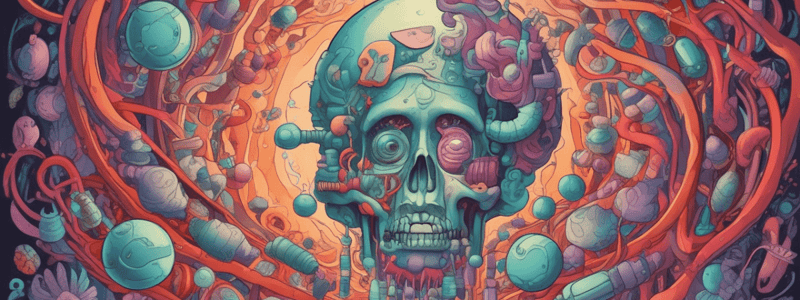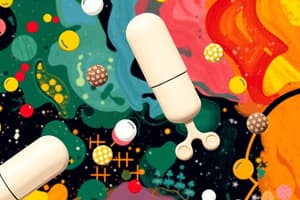Podcast
Questions and Answers
Which of the following are cholinergic drugs? (Select all that apply)
Which of the following are cholinergic drugs? (Select all that apply)
- Mirabegron
- Bethanechol (correct)
- Pilocarpine (correct)
- Atropine
Cholinergic drugs can have adverse effects such as diarrhea and increased salivation.
Cholinergic drugs can have adverse effects such as diarrhea and increased salivation.
True (A)
What is the primary use of Cevimeline?
What is the primary use of Cevimeline?
Treats dry mouth in Sjogren's syndrome
Atropine causes ______ receptor blockade.
Atropine causes ______ receptor blockade.
What condition is treated with Pyridostigmine?
What condition is treated with Pyridostigmine?
Which of these are side effects of Oxybutynin? (Select all that apply)
Which of these are side effects of Oxybutynin? (Select all that apply)
Irreversible cholinesterase inhibitors are primarily used as insecticides.
Irreversible cholinesterase inhibitors are primarily used as insecticides.
Match the following drugs to their primary effects:
Match the following drugs to their primary effects:
What is the treatment for muscarinic poisoning?
What is the treatment for muscarinic poisoning?
The main condition treated by neostigmine is ______.
The main condition treated by neostigmine is ______.
Which of the following drugs are considered catecholamines?
Which of the following drugs are considered catecholamines?
Adrenergic agonists can be administered orally.
Adrenergic agonists can be administered orally.
What is the therapeutic use of Alpha 1 adrenergic agonists?
What is the therapeutic use of Alpha 1 adrenergic agonists?
Epinephrine acts on all ___ adrenergic receptor subtypes.
Epinephrine acts on all ___ adrenergic receptor subtypes.
Which drug is a selective Beta 1 agonist used for heart failure?
Which drug is a selective Beta 1 agonist used for heart failure?
What are the main adverse effects of Beta 2 agonists?
What are the main adverse effects of Beta 2 agonists?
What is the primary use of Norepinephrine?
What is the primary use of Norepinephrine?
What should not be combined with Dobutamine?
What should not be combined with Dobutamine?
Which of the following are adverse effects of Alpha 1 antagonists?
Which of the following are adverse effects of Alpha 1 antagonists?
Beta blockers can help with hyperthyroid conditions.
Beta blockers can help with hyperthyroid conditions.
Clonidine is an indirect-acting anti-adrenergic agent used for ___ and ___ .
Clonidine is an indirect-acting anti-adrenergic agent used for ___ and ___ .
Flashcards are hidden until you start studying
Study Notes
Cholinergic Agonists/Antagonists
Cholinergic Drugs
- Mimic or block acetylcholine
- Contraindications:
- Lactating females: decrease milk production due to anticholinergic side effects
- Elderly: not recommended
Bethanechol
- Parasympathomimetic agent
- Selective agonist: muscarinic cholinergic receptor
- Binds reversibly to muscarinic cholinergic receptors, causing activation
- Uses:
- Urinary retention
- Investigational GI uses
- Off-label use for GI reflux
- Adverse effects:
- Hypotension
- Cramps from increased tone and motility of GI
- Diarrhea
- Increased salivation
- Asthma exacerbation
- Dysrhythmias in hyperthyroidism
- Contraindications:
- Hyperthyroid patients
Cevimeline
- Treats dry mouth in Sjogren's syndrome
- Derivative of acetylcholine
Pilocarpine
- Topical therapy for glaucoma
- Treats dry mouth from Sjogren's syndrome
Acetylcholine
- Rapid miosis after delivery in cataract surgery
Structure of Cholinergic Drugs
- Except for pilocarpine, they are quaternary ammonium compounds, always carrying a positive charge, and don't cross membranes easily
Muscarinic Poisoning
- Caused by ingestion of certain mushrooms or direct-acting muscarinic agonists, and cholinesterase inhibitors
- Symptoms:
- Profuse salivation
- Lacrimation
- Visual disturbances
- Bronchospasm
- Diarrhea
- Bradycardia
- Hypotension with possible cardiac collapse
- Treatment:
- Atropine and supportive therapy
Atropine
- Causes muscarinic receptor blockade
- Uses:
- Pre-anesthetic
- Disorders of the eye
- Bradycardia
- Intestinal hypertonicity/motility
- Muscarinic agonist poisoning
- PUD
- Asthma
- Biliary colic
- Adverse effects:
- Dry mouth
- Blurred vision
- Photophobia
- Elevation of intraocular pressure
- Urinary retention
- Constipation
- Anhidrosis
- Tachycardia
- Asthma
- Contraindications:
- Avoid combining with other drugs capable of causing muscarinic blockade
Anti-Cholinergic Drugs for Overactive Bladder
- Oxybutynin:
- Acts primarily at the M3 receptor
- Available in short-acting and long-acting forms
- Adverse effects:
- Dry mouth
- Constipation
- Tachycardia
- Urinary hesitancy/retention
- Mydriasis
- Blurred vision
- Dry eyes
- Hallucination/agitation in pediatrics and geriatrics
- Darfenacin:
- Treats overactive bladder
- Adverse effects:
- Dry mouth
- Constipation
- Solfenacin:
- Adverse effects:
- Dry mouth
- Blurred vision
- High doses can cause prolongation of QT interval
- Adverse effects:
- Tolterodine:
- Can prolong QT interval
- Adverse effects:
- Dry mouth
- Constipation
- Fesoterodine:
- Adverse effects:
- Dry mouth
- Constipation
- Adverse effects:
- Trospium:
- Adverse effects:
- Dry mouth
- Constipation
- Adverse effects:
- Mirabegron:
- MOA: relaxation during filling and increased bladder capacity, decreases frequency
- Adverse effects:
- Dry mouth
- Constipation
- Can prolong QT and increase BP
- Vibegron:
- Adverse effects:
- Dry mouth
- Constipation
- Adverse effects:
- Botox (onabotulinumtoxina):
- MOA: injected in detrusor muscle, inhibits calcium-dependent release of acetylcholine
- Adverse effects:
- Voiding dysfunction
- UTIs
SNRIs
- Duloxetine:
- Cannot be given with MAOIs and is metabolized by CYP
- Venlafaxine and Duloxetine:
- Non-traditional therapy
- Facilitates urine storage, augments PNS innervation, and inhibits sympathetic innervation
Other Muscarinic Antagonists (Anti-Cholinergic)
- Scopolamine:
- Similar to atropine
- Uses:
- Suppresses emesis and motion sickness
- Cycloplegia/mydriasis for eye symptoms
- Pre-anesthetic sedation/obstetric amnesia
- Ipratropium bromide:
- Uses:
- Asthma
- COPD
- Rhinitis from allergies or common cold
- Uses:
- Antisecretory anticholinergics:
- Reduce salivation
- Glycopyrrolate, Mepenzolate, Methscopolamine, and Propantheline
- Dicyclomine:
- Treats IBS, diarrhea, or hyper-motility
- Mydriatic-cycloplegics:
- Produce mydriasis and cycloplegia for eye procedures
- Atropine, homatropine, scopolamine, cyclopentolate, and tropicamide
- Centrally acting anticholinergics:
- Treats Parkinson's
- Benztropine and trihexyphenidyl
Anti-Muscarinic Poisoning
- Caused by natural products or selective anti-muscarinic drugs
- Symptoms:
- Dry mouth
- Blurred vision
- Photophobia
- Hyperthermia
- CNS effects
- Hot, dry/flush skin
- Death from respiratory depression
- Treatment:
- Physostigmine (inhibitor of acetylcholinesterase)
Cholinesterase Inhibitors
- Prevent degradation of acetylcholine by acetylcholinesterase, increasing levels of acetylcholine and enhancing cholinergic transmission
Reversible Cholinesterase Inhibitors
- Pyridostigmine:
- Does not cross membranes readily, absorbed poorly with oral administration, minimal effects on the brain and fetus
- Used for myasthenia gravis
- MOA: decreases breakdown of acetylcholine
- Adverse effects:
- Excessive muscarinic stimulation
- Neuromuscular blockade
- Precautions/contra:
- Obstruction of GI or urinary tract
- PUD
- Asthma
- Coronary insufficiency
- Hyperthyroidism
Irreversible Cholinesterase Inhibitors
- Highly toxic, primarily used as insecticides
- Only clinical indication: glaucoma
- Lipid soluble
- Poisoning: excessive muscarinic stimulation and depolarizing neuromuscular blockade, known as "cholinergic crisis"
- Treatment:
- Atropine
- Respiratory support
Myasthenia Gravis
- Fluctuating muscle weakness and predisposition to rapid fatigue
- Symptoms:
- Ptosis
- Dysphasia
- Weakness
- Autoimmune process where antibodies attack the nicotinic M receptors on skeletal muscle
- Treatment:
- Reversible cholinesterase inhibitors by preventing inactivation, anticholinesterase agents can intensify the effects of acetylcholine increasing muscle strength
- Atropine to suppress muscarinic responses if excessive
- Signs of improvement: ease of swallowing, ability to raise eyelids
- Overmedication: excessive salivation and other muscarinic responses
Adrenergic Agonists
- Referred to as sympathomimetics, with two classes: catecholamines and non-catecholamines
- Catecholamines:
- Contain a catechol group and amine group
- Metabolized by enzymes MAO and catechol-O-methyltransferase (COMT)
- Cannot be administered orally, have a brief duration of action, and cannot cross the blood-brain barrier (BBB)
- Examples: epinephrine, norepinephrine, isoproterenol, dopamine, and dobutamine
- Non-catecholamines:
- Do not contain a catechol group
- Not substrates for COMT, and metabolized slowly by MAO
- Have longer half-lives and can be given orally
- Can cross the BBB
- Receptor specificity:
- Albuterol: B2 at low doses, B1 and B2 at high doses
- Isoproterenol: B1 and B2
- Epinephrine: acts on all 4 adrenergic receptor subtypes (A and B)
- Selectivity is relative and depends on the dose
- Adrenergic agonist drugs:
- Epinephrine:
- Uses: delaying absorption of local anesthetics, control of superficial bleeding, increase in blood pressure, and mydriasis
- Adverse effects (AE): hypertension crisis, dysrhythmias, angina, and necrosis following extravasation
- Norepinephrine:
- Uses: hypotensive states and cardiac arrest
- AE: tachydysth, angina, hypertension, and local necrosis
- Isoproterenol:
- Uses: AV block, cardiac arrest, and increase in cardiac output
- AE: tachyarrhythmias, angina, and hyperglycemia in diabetes
- Dopamine:
- Uses: shock and heart failure
- AE: tachy, dysrhythmias, anginal pain
- Dobutamine:
- Uses: heart failure
- AE: tachy
- Phenylephrine:
- Uses: locally to reduce nasal congestion, and parenterally to increase blood pressure
- AE: hypertension, necrosis of tissue, and bradycardia
- Albuterol:
- Uses: asthma through bronchodilation
- AE: tremor and tachy
- Ephedrine:
- Uses: asthma, shock, and anesthesia-induced hypotension
- AE: hypertension, dysrhythmias, angina, and hyperglycemia in diabetes
- Epinephrine:
Adrenergic Antagonists
- All adrenergic antagonists produce reversible competitive blockade
- More selective than agonists, with alpha and beta antagonists blocking specific groups
- Alpha blocking agent:
- Uses: hypertension, reversal of toxicity from alpha agonist, benign prostatic hyperplasia (BPH), pheochromocytoma, and Raynaud disease
- AE: orthostatic hypotension, reflex tachycardia, nasal congestion, inhibition of ejaculation, and nausea retention
- Alpha 1 blocking agent:
- Prazosin, doxazosin, tamsulosin, alfuzosin, and silodosin
- Uses: hypertension, BPH, and pheochromocytoma
- AE: postural hypotension, abnormal ejaculation, and increased risk of rhinitis
- Alpha 2 blocking agent:
- Phentolamine and phenoxybenzamine
- Uses: pheochromocytoma, prevention of tissue necrosis, and reversal of soft tissue anesthesia
- Beta blocking agent:
- Uses: anti-anginal therapy, hypertension, dysrhythmias, myocardial infarction, heart failure, hyperthyroidism, migraine, pheochromocytoma, and stage fright
- AE: bradycardia, bronchoconstriction in asthma patients, and hypoglycemia in diabetes
- Beta blocking agent:
- Propranolol, metoprolol, labetalol, carvedilol, and esmolol
- Uses: hypertension, angina, dysrhythmias, and myocardial infarction
- AE: bradycardia, bronchoconstriction, and hypoglycemia in diabetes
Indirect-Acting Anti-Adrenergic Agents
- Clonidine:
- Indication: hypertension, pain, and ADHD
- A2 adrenergic agonist that causes selective activation of A2 receptors in the CNS
- Causes bradycardia and decreased cardiac output
- Lipid soluble
- AE: drowsiness, xerostomia, rebound hypertension with withdrawal, constipation, impotence, gynecomastia, and adverse CNS effects
- Guanfacine:
- Same as clonidine
- Methyldopa:
- Oral antihypertensive that acts on CNS sites
- AE: hemolytic anemia and hepatic necrosis
- Great for pregnancy
- Methyldopate:
- IV antihypertensive
- AE: positive Coombs test, hemolytic anemia, hepatic toxicity, xerostomia, sexual dysfunction, orthostatic hypotension, and CNS effects
Studying That Suits You
Use AI to generate personalized quizzes and flashcards to suit your learning preferences.




